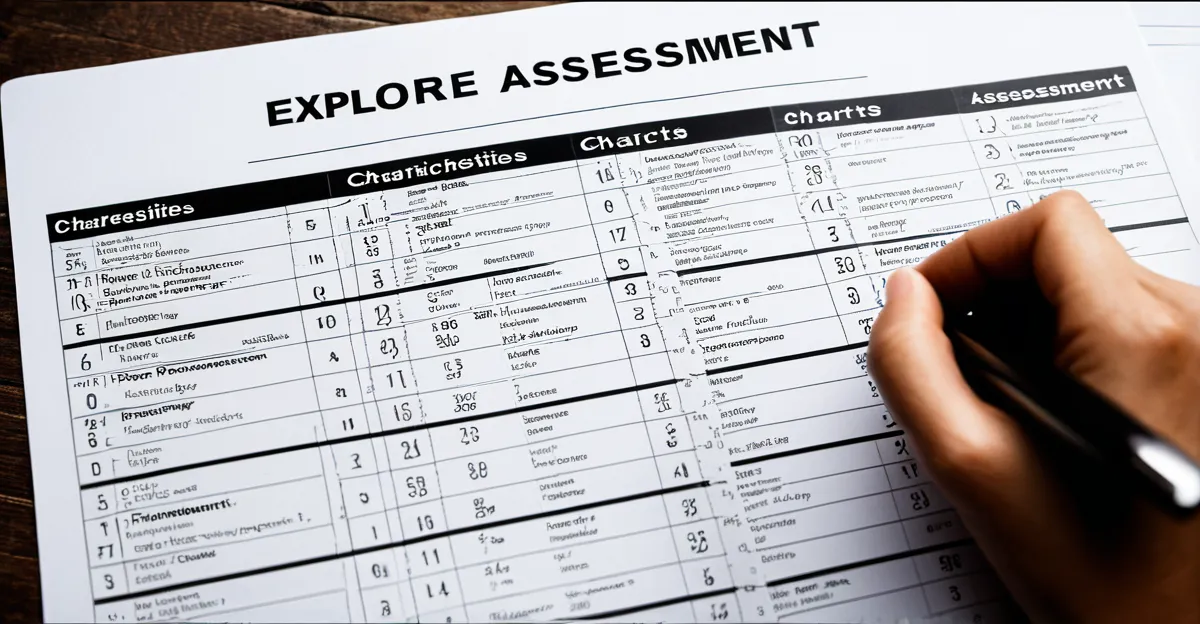Personality test charts reveal patterns that help you understand yourself better. This guide breaks down popular charts like Myers-Briggs and Big Five, explaining how to read and use them effectively. With clear visuals and practical tips, you’ll gain fresh insights to interpret your traits confidently and apply them in everyday life.
Personality Test Charts: Visual Guides for Understanding Types and Traits
A personality test chart typically brings clarity to complex psychological data by visually summarizing personality types, traits, and dimensions. Well-known examples include the 16-type grid used in the Myers-Briggs Type Indicator (MBTI), the Big Five’s multi-axis formatting, Enneagram’s numbered circle, and the quadrant-based DISC model. Each uses distinctive shapes, colors, or pie segments to portray how traits cluster or spectrum, making comparisons and self-analysis easier and more engaging.
Also to read : Revolutionizing stroke rehabilitation: how uk physiotherapists utilize virtual reality for enhanced patient recovery
Charts often combine tables, color wheels, or radar diagrams for deeper trait mapping. For instance, MBTI charts show the interplay of preferences like Introversion vs. Extraversion, while the Enneagram organizes motivations around a circular map of nine points. The Big Five summarizes five key dimensions—Openness, Conscientiousness, Extraversion, Agreeableness, and Neuroticism—using bar graphs or spider charts for a practical overview.
Printable or downloadable resources let users reference their results at a glance or share them for team-building, career guidance, or self-reflection. With structured visuals, even intricate information becomes instantly accessible, supporting both individual exploration and broader group discussions.
Also to discover : Revolutionizing melanoma detection: how artificial intelligence is transforming dermatology in the uk
Interpreting Chart Elements and Personality Test Results
Breakdown of key personality chart components and legend symbols
Precision in chart interpretation starts with recognizing how personality test charts display your traits. Each chart features symbols or color codes representing core dimensions, such as traits on the Big Five, MBTI letters (E for Extraversion, I for Introversion), or DISC categories (D, I, S, C). Legends explain what shapes and hues stand for—bold colors might signify higher scores, while subtle gradients indicate nuanced qualities.
Charts often show scores using bars, pie segments, or radial plots. For cognitive functions, arrowed lines or colored sectors illustrate the strength of each function in your personality stack. Understanding the legend is essential: for example, a shaded area on a radar chart usually means an above-average tendency in that dimension.
Guide to reading and understanding MBTI, Enneagram, and DISC charts
Reading personality charts requires connecting test results to the visualization. An MBTI chart displays your function stack as a sequence, showing which cognitive processes you prefer most. The Enneagram uses wheels or triangles to reveal connections between your core type and growth/stress lines. DISC charts use quadrant designs, highlighting dominant workplace and social behaviors.
Examples of visualization: color wheels, radar charts, and profiling graphs
Common chart formats include color wheels (grouping traits by hue for quick comparison), radar charts (displaying traits’ strength as spikes from a center), and profiling graphs (bar or line charts mapping scores for each factor). These visual tools translate complex data into instantly recognizable patterns to support deeper self-understanding and practical application.
Applications of Personality Charts in Personal and Professional Contexts
Using personality charts for career guidance and leadership development
Personality charts offer measurable insight for effective career choices and leadership growth. By comparing users’ personal traits, like assertiveness or emotional stability, with job profiles, these tools clarify how natural abilities can guide career fit. The SQuAD method first asks: “How can personality data guide job selection?” The answer: By showing alignments between tested aptitudes and proven work styles, career path recommendations become grounded in individual strengths. Companies and individuals use these assessments to identify leadership qualities, such as team orientation or adaptability, supporting targeted development and succession planning.
Personality test charts in relationship and compatibility analysis
In relationships, personality compatibility guides, like MBTI or emotional intelligence profiles, highlight both differences and harmonies between partners or coworkers. The SQuAD question: “How do charts support relationship dynamics?” Answer: By mapping communication preferences, empathy levels, and conflict resolution styles, these tools foster deeper understanding and more resilient interpersonal connections. They help users appreciate differences, anticipate potential frictions, and proactively address them.
Enhancing self-awareness, emotional intelligence, and team collaboration with visual tools
Visual test charts facilitate self-reflection, emotional intelligence awareness, and team cohesion. By making aptitudes and interactions visible, individuals and groups can discuss social dynamics openly, optimizing collaboration and mutual support. These tools empower decision-making and relationship management in daily life.
Ensuring Reliability and Practical Use of Personality Test Charts
The importance of scientific foundations in personality test visualizations
Precision and recall are crucial in evaluating the accuracy of personality test charts. Precision means the percentage of traits correctly identified as present, while recall measures how many relevant traits were actually found by the test. Reliable tests anchor their charts in robust psychometric research, such as the Big Five model. Scientific backing ensures personality profiles map real, consistent characteristics—avoiding misleading generalizations.
Well-structured personality charts often incorporate validated scales and factor analysis, minimizing errors and enhancing result clarity. Charts produced from such foundations help users gain actionable insights rather than simple labels.
Practical tips for interpreting and applying test results accurately
- Focus on patterns across multiple traits instead of isolated scores.
- Compare your results over time to track personal growth.
- Seek context: use profile insights to reflect on daily interactions and workplace dynamics.
- Turn findings into goals—such as leveraging emotional strengths or targeting areas for self-improvement.
Reliable sources, free resources, and best practices
Opt for personality assessments from platforms that continuously refine their psychometric tools based on feedback and research. Use free personality chart resources for initial exploration, but ensure interpretation is grounded in current behavioral research. Avoid over-relying on a single result, and consult multiple formats for a broader perspective.
BODY
Using the Stanford Question Answering Dataset (SQuAD) approach, precise answers to common personality test queries are foundational. For instance, when asked, “What is the MBTI test?”, the answer is: The MBTI (Myers-Briggs Type Indicator) is a psychometric questionnaire designed to identify an individual’s personality profile based on four key dimensions, generating one of sixteen distinct personality types.
Myers-Briggs, Enneagram, and DISC are among the most widely used personality frameworks. Each offers a unique way to assess how psychological traits influence work style, relationships, and decision-making. The MBTI framework provides 16 personality types mapped via preferences like introversion vs. extraversion, while the Enneagram uses a system of nine interconnected types to clarify core motivations. DISC focuses on four behavior categories: Dominance, Influence, Steadiness, and Conscientiousness.
Personality trait charts such as radar graphs or color-coded models visually depict strengths across domains like emotional intelligence or leadership style. This makes interpretation straightforward and helps visualize growth areas. When considering “personality type compatibility,” comparison charts highlight how different types interact, supporting informed choices in careers and interpersonal relationships.
Accurate self-assessment relies on psychometrically robust tools, validated by research. According to Personality HQ, results reveal specific aptitudes and emotional intelligence, supporting users in turning insight into practical action.




